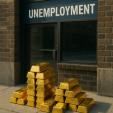What Gold Volatility, Stanley Fischer, And CBDC Can Tell Us About The Future
The insights below were gathered from an excellent article by Matthew Piepenburg of Matterhorn Asset Management on “the implications behind central bank gold purchases (rising), negative real yields (falling), and Stanley Fisher’s Fed-speak (cringing).”
Central Banks Are Buying Gold Like Mad! Why?
You really need to watch what central banks are doing rather than what they are saying because, more often than not, their words are designed to get the masses to behave in a manner that best protects their shareholders and governments that depend on them. The least of their interests is the public as a whole. In the U.S., the Fed’s shareholders are major money center banks. So while the Fed and western central bankers show no desire to buy gold (although Germany demanded delivery of what they owned overseas during the last few years), nations that are building their gold reserves are those not aligned closely to the U.S. Empire.

China and Russia are not noted on the above chart, as they have been huge hoarders of gold over the past decade. Thailand, Hungary, and Brazil have been the really big buyers of physical metal during the first six months of 2021. In the first half of 2021, global gold reserves at the central banks expanded by 333 tons, which is almost 40% above the five-year average. These three nations are very familiar with the pain of importing U.S. inflationary policies and thus seeking to store their wealth in real stores of value. The current pace of post-World-War-II central bank gold buying is already set to surpass the previous record set in 2018 (651 tons).
Negative Real Rates & the Need to Buy Gold
The mainstream media will attribute the purchase of gold by central banks to COVID rather than to the fact that the Fed and other central banks are caught in a debt vortex from which they cannot escape. Starting with Alan Greenspan after the 1987 stock market crash and the creation of the President’s Working Group (AKA the Plunge Protection Team), the Fed committed itself to printing money as a “solution” to keep stock prices elevated. The theory was that high asset prices (stocks, real estate, etc.) had a “wealth effect” that would keep the demand side of the economy strong and thus could be used to avoid major market declines. Or if one occurred, as in 1987, 2000, and 2008 then the Fed could simply stimulate higher prices with debt-based fiat money.
At first this strategy appeared to work like a charm as the Fed paddled its way to the edge of the debt vortex. But keep in mind that fiat money is manufactured with debt, starting with Federal Government debt that is funded either by savers who purchase Treasuries or, in the absence of serious purchasers of U.S. Treasuries like now, by money created out of thin air by the Federal Reserve. Had U.S. debt levels stayed below 100% of GDP, the future might not seem so bleak, but in general, the 100% level is considered the point of no return in the vortex in which a country’s currency is likely to get flushed down the drain to its end. It is at that point where the burden of interest starts to weigh heavily on a country’s ability to service its debt.
In 2019, Fed Vice Chair Stanley Fischer observed that “It would not take much of a shock to growth…for the debt ratio to balloon and spark concerns about debt sustainability.” When Stanley Fischer spoke these words in 2019, the U.S. debt to GDP ratio was at 105%. Since then, it has grown to 130%. In other words, the central bankers are running out of time.
Another dynamic that is sucking the U.S. dollar down to the point of “no return” in the vortex are negative real interest rates which must be maintained and actually accelerated now to keep asset prices elevated, which in turn is essential to keep the entire economy from collapsing. Forget any kind of meaningful real growth with inflation rates now accelerating with no end in sight. So the Fed has paddled its way into the debt vortex from which there is no non lethal way of escape. Not only are rates negative now but they also are going to become much more negative, and that is hugely bullish for gold and silver. As noted by Mr. Piepenburg, “Looking forward, unless real (i.e., inflation-adjusted) rates rise measurably, gold prices will rise sharply.”
“Why are we so confident of this?”
Excerpted from Jay Taylor’s MiningStocks.com:
*********
















